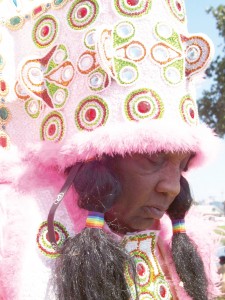Big Chief Thomas Sparks Sr. has died
19th March 2018 · 0 Comments
By Geraldine Wyckoff
Contributing Writer
Big Chief Thomas Sparks was a Mardi Gras Indian for a lifetime. The chief of the Yellow Jacket Black Indian gang, Sparks first started masking in 1947 and in 2015, he was still wielding a needle and thread. “I’m still sewing – yeah, I’m getting ready,” Sparks proudly declared in an interview prior to Carnival 2015. Uniquely, Mardi Gras fell on his birthday just as it did in 2012. Thomas “Big Chief Tom” Sparks Jr. died on Wednesday, March 14, 2018 at the age of 86.
Even as a little boy, Sparks would follow the Indians. “When I seen them, I was right behind them,” he remembered. His childhood curiosity in the culture was also ignited by the fact that his mother was a full-blooded Native American of the Cherokee nation. He first started masking in 1947 and held the position of flagboy with the Bumble Hunters. The gang came out of the 7th Ward and Sparks remembered meeting other gangs like Allison “Tootie” Montana’s father, Alfred, who pulled the Monogram Hunters, as well as the notorious Black Benny and Brother Tillman.
He continued with the Hunters until he entered the military to serve in the Korean War. When Sparks was discharged from the service in 1953, he joined the Yellow Jacket gang, then under the leadership of Chief Val. He entered as a flagboy though in a rather unprecedented move, just two years later, Chief Val jumped Sparks up to the position of chief. His first suit as chief was white and in a 2012 interview he remembered that at that time, there were an amazing 90 members of the gang who hit the street on a Carnival day.
Sparks was a highly respected man and member of the Mardi Gras Indian community whose influences were wide-spread. Family was always an important aspect of the Yellow Jackets and at some point in their lives, all of Sparks’ children – six girls and one boy – masked Indian. His wife, Barbara, reigned as the innovative Big Queen of the Yellow Jacket gang, a position she played with great spunk and flair. “She always had my back,” Sparks once declared.
Another of Sparks’ relatives, who came up under his tutelage, is his nephew Big Chief Little Charles Taylor. Renowned for his great voice that projects over a crowd, Taylor, who formed his own gang, the White Cloud Hunters in 1982, credits Sparks for his singing ability and more. “He took me to the Indian practices and I would hear him singing and I used to try to sing — I got good at it,” Taylor once said. “He’s a guy who would explain stuff to you about being an Indian. He’ll show you how to dress it up. He just takes and guides you. He taught me how to thread the needle and to lock down the pearl. He taught me how to sew the material around the apron before you sew the stuff on it. He taught me how to sew neat, how to keep things in line and how to correspond the colors.” He was like a son to me,” Sparks once declare of Taylor.
Sparks’ competitive nature was also realized in his other passion, pigeon racing. Just outside Sparks’ bedroom with its closet full of Indian suits, was an impressive 8’x10’ coop that at one time housed as many as 75 homing pigeons. Clarence “Chief Delco” Delcour, of the Creole Osceola Black Indian gang, was inspired by Sparks to raise pigeons. “He always did set an example,” Delcour once said.
A retired mason and carpenter as well as a master designer and sewer, Big Chief Thomas did credit Big Chief Allison “Tootie” Montana for teaching him the art of three-dimensional design. “I’m the kind of person if I don’t know something, I ask somebody,” Sparks has said.
Big Chief Sparks, whose suits were once constructed with old jewelry, broken mirrors and cheese cloth, performed at the first Jazz Fest at the Fair Grounds and has traveled to Europe demonstrating the art of making an Indian suit. His decades working that needle and thread and his lifetime of masking Indian never diminished his enthusiasm for the culture or his creativity.
“It’s good to have somebody of that age masking because it keeps part of the old customs going,” Sylvester Francis, the director of the Backstreet Cultural Museum,” offered back in 2012. “He really doesn’t have to be out there. He paid his dues. He’s out there for the love.”
As a flagboy and as a chief, Thomas Sparks filled his role as an influential and enthusiastic member of the Mardi Gras Indian nation. In doing so, he passed on some of his great knowledge of the culture, the tradition and the art.
Funeral arrangements for the Big Chief are pending.
This article originally published in the March 19, 2018 print edition of The Louisiana Weekly newspaper.




